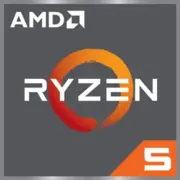AMD Ryzen 5 6600U

AMD Ryzen 5 6600U: The Perfect Balance for Mobility and Performance in 2025
March 2025
Architecture and Process Technology: Zen 3+ and 6nm Technologies
The AMD Ryzen 5 6600U processor, developed under the codename Rembrandt, continues the tradition of energy-efficient solutions for ultrabooks. It is built on the Zen 3+ architecture optimized for mobile devices and is manufactured using the 6nm TSMC FinFET technology. This provides high transistor density with moderate power consumption.
- Cores and Threads: 6 cores and 12 threads. Base frequency is 2.9 GHz, turbo boost frequency goes up to 4.5 GHz.
- Cache: 16 MB L3 cache, improving responsiveness in multitasking scenarios.
- Integrated Graphics Radeon 660M: 6 compute units (CUs) with a frequency of up to 1.9 GHz. Supports DirectX 12 Ultimate, FidelityFX Super Resolution (FSR), and 4K output.
The architecture of Zen 3+ brings 5–8% IPC (instructions per cycle) improvements compared to Zen 3, along with better power management. This makes the processor particularly efficient in variable load tasks.
Power Consumption and TDP: 15W for Thin Laptops
The processor TDP is 15W, which is typical for ultrabooks. However, thanks to dynamic frequency (Precision Boost 2) and voltage management, the chip adapts to tasks:
- In idle mode, consumption drops to 1–3W.
- Under peak load (e.g., video rendering), power briefly reaches 25–28W, but the cooling system quickly brings it back to the nominal level.
This flexibility allows the Ryzen 5 6600U to be used in devices less than 15mm thick without active cooling, although most models are equipped with compact fans for stable performance under load.
Performance: From Office Work to Light Gaming
Geekbench 6 shows solid results:
- 1690 points in single-core tests — enough for fast operation of applications like Photoshop or Visual Studio Code.
- 6613 points in multi-core — parallel data processing, code compilation, or streaming happens without delays.
Real-World Scenarios:
- Office Tasks: Simultaneous work with 20+ tabs in Chrome, Excel sheets, and Zoom — the processor handles it without throttling.
- Multimedia: Converting a 30-minute video to 1080p using HandBrake takes about 12 minutes.
- Gaming: In Dota 2 (1080p, medium settings), the Radeon 660M delivers 50–60 FPS. With FSR 2.0 activated in Cyberpunk 2077 (720p, low settings) — around 35 FPS.
Turbo Mode: Under brief loads (up to 2–3 minutes), the frequency rises to 4.5 GHz, but after reaching 95°C, it starts to decrease to 3.8–4.0 GHz. For long tasks (e.g., rendering), the stable frequency is around 3.2 GHz.
Usage Scenarios: Who is the Ryzen 5 6600U For?
1. Students and Office Workers: Lightweight laptops with battery life of 8–10 hours.
2. Digital Nomads: Sufficient power for photo editing and light video work.
3. Casual Gamers: Games like CS:GO, Valorant, Minecraft at medium settings.
4. Users Who Value Quiet Operation: Passive cooling in some models (e.g., Lenovo Yoga Slim 7).
Not Suitable For:
- Professional gamers (requires a discrete GPU).
- Engineers working with 3D modeling or 4K video.
Battery Life: How the 6nm Process Saves Charge
Laptops with the Ryzen 5 6600U demonstrate 8–12 hours of operation under moderate use (web surfing, office applications). This is achieved through:
- Adaptive Power Management: Dynamic deactivation of unused cores.
- Efficient 6nm Process Technology: Lower power leakage compared to 7nm chips.
- Support for LPDDR5-6400: Low-voltage memory reduces overall system power consumption.
In power-saving mode (Windows Battery Saver), runtime can be extended to 14 hours, but performance drops by 20–25%.
Comparison with Competitors: AMD vs Intel vs Apple
- AMD Ryzen 5 7640U (Zen 4): 15–20% faster in multi-threaded tasks but more expensive ($900+).
- Intel Core i5-1340P (Raptor Lake): Comparable performance but higher power consumption (up to 18 hours of battery life versus 12 for AMD).
- Apple M2: Better energy efficiency (up to 18 hours of operation) but limited gaming compatibility and starting price of $1100.
The Advantage of Ryzen 5 6600U: Optimal price-performance ratio ($700–850 for a laptop) with gaming potential from the iGPU.
Pros and Cons
Strengths:
- High energy efficiency.
- Powerful integrated graphics for TDP of 15W.
- Support for PCIe 4.0 and Wi-Fi 6E.
Weaknesses:
- No support for Thunderbolt 4 (only USB4 in some models).
- Budget laptops may have weak cooling systems.
Laptop Selection Recommendations
1. Device Type: Ultrabook (Acer Swift 3, Asus ZenBook 14) or 2-in-1 hybrid (HP Spectre x360).
2. Screen: IPS panel with 300 nits brightness and 100% sRGB coverage for color work.
3. RAM: At least 16 GB LPDDR5 (soldered memory, non-upgradable).
4. Storage: 512 GB NVMe SSD (better with PCIe 4.0).
5. Battery: At least 50 Wh for over 8 hours of battery life.
Model Examples for 2025:
- Lenovo ThinkBook 14 G6: $749, 16 GB/512 GB, 14-inch 2.2K screen.
- Dell Inspiron 15 5535: $799, FHD touchscreen, 53 Wh battery.
Final Conclusion
The AMD Ryzen 5 6600U in 2025 remains a relevant choice for anyone looking for a versatile laptop under $800 with good battery life and the ability to perform not just basic tasks. It is an ideal option for:
- Users who frequently work on the go.
- Students balancing studies and entertainment.
- Those who want to avoid overpaying for "premium" chips while still getting 80% of their capabilities.
Key benefits: price, battery life, quiet operation, and support for modern technologies without compromising everyday performance.
Basic
CPU Specifications
Memory Specifications
GPU Specifications
Miscellaneous
Benchmarks
Compared to Other CPU
Share in social media
Or Link To Us
<a href="https://cputronic.com/en/cpu/amd-ryzen-5-6600u" target="_blank">AMD Ryzen 5 6600U</a>